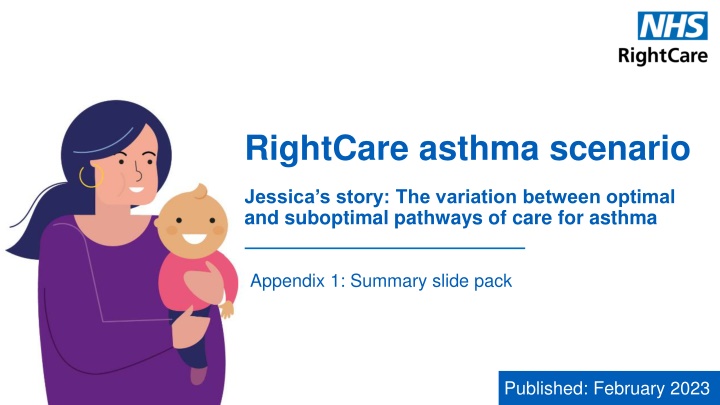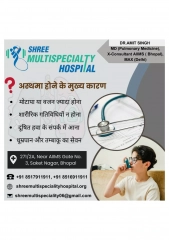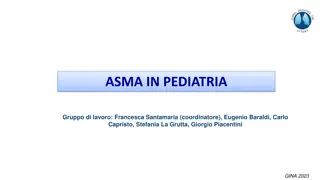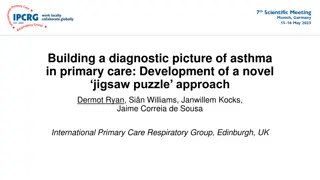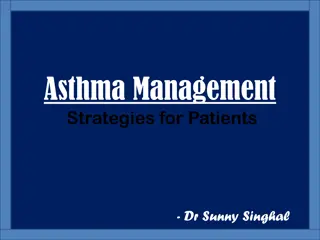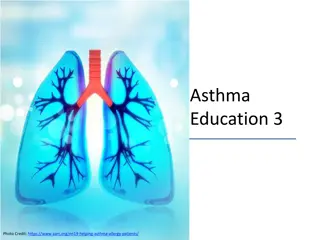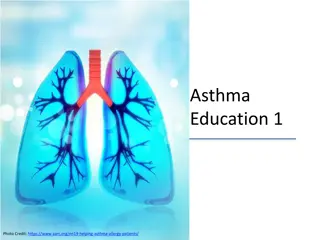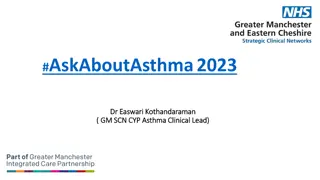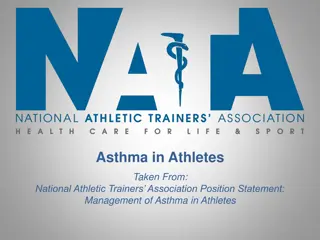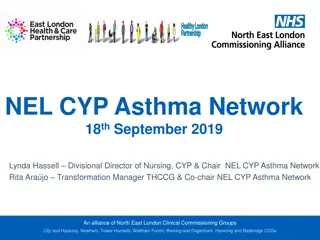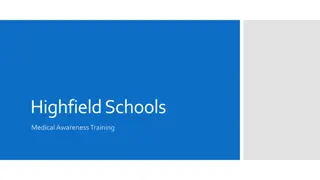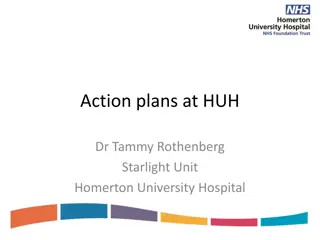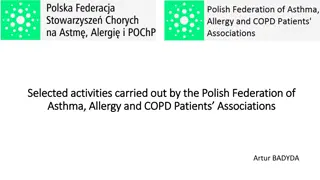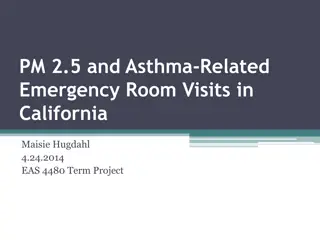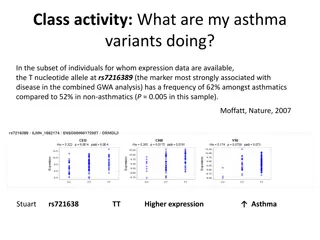RightCare asthma scenario
Jessica's asthma care journey is examined, highlighting the impact of optimal versus suboptimal pathways on her health outcomes and experiences. The scenario showcases the importance of proper asthma management and the consequences of inadequate care over time, emphasizing the need for personalized treatment plans and preventative measures.
Download Presentation

Please find below an Image/Link to download the presentation.
The content on the website is provided AS IS for your information and personal use only. It may not be sold, licensed, or shared on other websites without obtaining consent from the author.If you encounter any issues during the download, it is possible that the publisher has removed the file from their server.
You are allowed to download the files provided on this website for personal or commercial use, subject to the condition that they are used lawfully. All files are the property of their respective owners.
The content on the website is provided AS IS for your information and personal use only. It may not be sold, licensed, or shared on other websites without obtaining consent from the author.
E N D
Presentation Transcript
RightCare asthma scenario Jessica s story: The variation between optimal and suboptimal pathways of care for asthma Appendix 1: Summary slide pack Published: February 2023
Jessicas story: This is the story of Jessica s experience of an asthma care pathway, and how it could be so much better. At each stage we have modelled the costs of care, financially to the commissioner, and also the impact on the person and their family s outcomes and experience. In this scenario we examine an asthma care pathway, comparing a suboptimal but realistic scenario against an optimal pathway. 1 2 4 3 This document is intended to help commissioners and providers to understand the implications, both in terms of quality of life and cost, of shifting the care pathway. It shows how the RightCare methodology can help clinicians and commissioners to improve the value and outcomes of the care pathway.
Introducing Jessica Jessica is 28 years old and has been married for four years. She has two children, aged four and 18 months old, and works part time as a supervisor in a busy local supermarket. Jessica knows her health could be better. She is overweight, rarely exercises and smokes around 10-15 cigarettes a day. She had mild asthma as a child and her symptoms were well controlled. At the age of 16 she stopped using her asthma medication as she didn t feel she needed it. In January she started to feel ill with a chest infection. Her symptoms deteriorated and she began to feel acutely ill. She made an appointment to see her GP.
Jessica and the sub-optimal pathway January, year 1: Jessica s first interaction with primary care Jessica sees her GP due to wheezing and a chest infection. Her GP diagnoses winter bronchitis and prescribes antibiotics. This continues for two years with the breathlessness and wheezing gradually getting worse. March, year 3: Jessica has her first asthma attack Jessica has an asthma attack and goes to A&E where she is given a suggested diagnosis of asthma and a prescription for oral corticosteroids (OCS). The hospital sends Jessica s GP a brief attendance summary and a follow-up appointment is made by her GP practice. Jessica cancels the appointment as she feels well due to the steroids. This is not challenged or followed up by the practice. May, year 3: Jessica s symptoms continue uncontrolled Two months later, Jessica's symptoms return. She sees her GP who diagnoses asthma after reviewing the hospital letter. They start Jessica on low dose inhaled corticosteroids (ICS) but does not show Jessica how to use the inhalers correctly. Jessica s general lifestyle and health is not discussed. As Jessica is not using her inhalers correctly her symptoms continue uncontrolled. June, year 3: Jessica has a second asthma attack Jessica has a second severe asthma attack and is taken to A&E via ambulance. Jessica sees her GP the next day but there is little focus on prevention and risk factors. She is not asked to demonstrate her inhaler technique. Eight weeks later, Jessica attends a follow-up appointment where the GP asks about her use of asthma inhalers, Jessica is unaware of her poor technique and no further guidance on the correct usage is given. Due to her worsening symptoms the GP increases her dose of ICS. There is no risk assessment or Personalised Asthma Action Plan (PAAP) in place, which would help her identify her triggers and manage her condition. February, year 6: Conclusion and impact of suboptimal care By year 6, Jessica has had six more serious asthma attacks resulting in unscheduled A&E visits. After each visit, her GP is contacted to arrange a follow-up appointment but she doesn t always attend as she doesn t feel these help. She has not been referred to a consultant with a specialist interest in asthma and still has no PAAP. Jessica continues having regular asthma attacks which affect her work and personal life. She becomes disillusioned and stops engaging with health services.
Jessica and the optimal pathway January, year 1: First interaction with primary care Jessica sees her GP due to wheezing and a chest infection. The GP conducts an in-depth review of her history and general health and considers asthma. They start her on appropriate treatment, explaining optimal inhaler technique and advises Jessica to speak to her pharmacist for more information. January, year 1: Timely diagnosis Jessica sees the asthma nurse within two days. Objective tests are used to confirm the diagnosis of asthma and her details are added to the practice asthma register. Treatment is prescribed and appropriate asthma education is provided with special attention on correct inhaler technique. A Personalised Asthma Action Plan (PAAP) is developed to help Jessica self-manage her asthma and avoid triggers. Her general health and lifestyle is discussed with recommendations for improvement. February, year 1: Jessica s asthma is monitored, and symptoms are controlled Jessica is still experiencing asthma symptoms so sees the asthma nurse who modifies her medication accordingly and reviews her inhaler technique. Over the next two years Jessica continues to have annual reviews. Her living and work conditions are discussed to identify risks. Jessica feels confident about managing her condition and in using her inhalers. Jessica has successfully quit smoking and receives the pneumococcal vaccination following contact from the GP. Having asthma has not impacted her life as her symptoms are well managed. March, year 3 - Jessica has her first asthma attack and appropriate follow-up Two years since diagnosis, Jessica has a severe asthma attack at work and is taken to A&E. She receives appropriate treatment and sees an asthma nurse who reviews and updates her PAAP. A follow-up appointment is booked in primary care within two working days where her inhaler technique is reviewed and the importance of adhering to the medication is explained. Six weeks later Jessica has another review with the asthma nurse to ensure symptoms were under control. A completed asthma control questionnaire confirms she has good control of her asthma symptoms. February, year 5 - Conclusion and impact of optimal care For the next two years Jessica continues to have annual reviews with the asthma nurse where they review her PAAP, inhaler technique and adherence. Since being diagnosed Jessica has only been to A&E once. Her symptoms have been under control since her attack and she is confident in managing her asthma. Jessica is constantly vigilant of her triggers and avoids them where possible or takes action to minimise their effect. She is more active than she s ever been and is losing weight.
Key themes of optimal care Objective tests to support diagnosis Correct inhaler technique Personalised Asthma Action Plan (PAAP) Monitoring asthma control Importance of urgent follow-up NICE Quality statement 1: People aged 5 years and over with suspected asthma have objective tests to support diagnosis. Good technique is essential in ensuring optimum use of inhaler devices. NICE Quality statement 2: People aged 5 years and over with asthma discuss and agree a written personalised action plan. Download it from the Asthma + Lung UK website. NICE Quality statement 3: People with asthma have their asthma control monitored at every asthma review. NICE Quality statement 4: People who receive treatment in an emergency care setting for an asthma attack are followed up by their general practice within two working days of discharge. Inhalers should only be prescribed after the person (or their carer) has received training in its use and has demonstrated an acceptable technique. Repeated checks are essential, as poor technique, even after training, is common. Inhaler technique should be reassessed as part of a structured clinical review during follow-up. Information about correct inhaler technique can be found on the Asthma + Lung UK website. Monitoring of asthma control at every asthma review helps to identify if control is suboptimal. If suboptimal asthma control is identified, the person should have an assessment to identify possible reasons for this, including adherence and inhaler technique, before their treatment is adjusted. Monitoring asthma control and addressing any problems identified will improve quality of life and reduce the risk of serious asthma attacks and hospital admissions. Asthma can be misdiagnosed. Following taking an initial history and assessment, objective tests can help healthcare professionals to diagnose asthma correctly in people over 5 years. There is no single objective test to diagnose asthma and the correct initial test may identify the need for further tests. A Personalised Asthma Action Plan (PAAP) contains all the information that people need to manage their asthma. People who have one are better equipped to manage their symptoms and so less likely to be admitted to hospital for their asthma. The plan should be completed with the GP or asthma nurse and reviewed and updated at every review. People who have recently had emergency care for an asthma attack may be at risk of another attack. Timely follow-up in general practice after discharge from emergency care allows healthcare professionals to check that the asthma is responding to treatment, to explore the possible reasons for the attack and to give support and advice about reducing the risk of further attacks.
Financial information Not only is Jessica s health and quality of life significantly better in the optimal care pathway, but the costs to the healthcare system are estimated to be 75% lower. The impact is significant on outcomes, quality and finance. Sector Primary care Secondary care Ambulance Community pharmacy Medicines Total Optimal ( ) 397 195 0 126 866 1,584 Suboptimal ( ) 404 3,384 2,377 0 198 6,363 National average costs and similar data sources have been used to calculate the indicative healthcare costs of two hypothetical pathways of care for an individual fictionalised typical person, and therefore do not represent the local cost of service provision. It is recommended that systems work with local clinical leaders and costing colleagues to map existing pathways, taking into account local circumstances and evidence, and reflecting the make-up of the local population and services already in place.
Areas for systems to consider Are there processes in place to ensure that health care professionals caring for patients have the correct training and resources to use appropriate objective tests to help diagnose asthma? 1 Who has responsibility for ensuring that there is a framework in place to provide a consistent approach in the use, development and management of PAAPs, and that healthcare professionals are sufficiently trained? 2 Is optimal inhaler technique promoted and encouraged in your local health system? Are healthcare staff trained in the correct technique and is the technique of all individuals with asthma reviewed regularly? 3 Is the use of inhaled corticosteroid (ICS) inhalers actively encouraged to improve disease management and reduce unnecessary SABA use? And are environmentally friendly options discussed with individuals to support the Greener NHS programme? 4 Are processes in place to ensure that patients have annual reviews (or more regular when appropriate such as following an asthma attack) and what checks are in place to confirm that their asthma control is being checked and monitored? 5 Is there a clear and recognised communication process in place between secondary and primary care to ensure that practices are informed when their patients have been treated within 48 hours? If not, what and where are the communication blockages? 6 Who has responsibility to ensure that pathways exist to identify and review patients with difficult to control asthma and to refer those who need it to secondary care? 7
Further information For more information about Jessica s journey or RightCare: rightcare@nhs.net www.england.nhs.uk/rightcare www.future.nhs.uk/NationalRightCare @NHSRightCare Click here for the full asthma scenario
